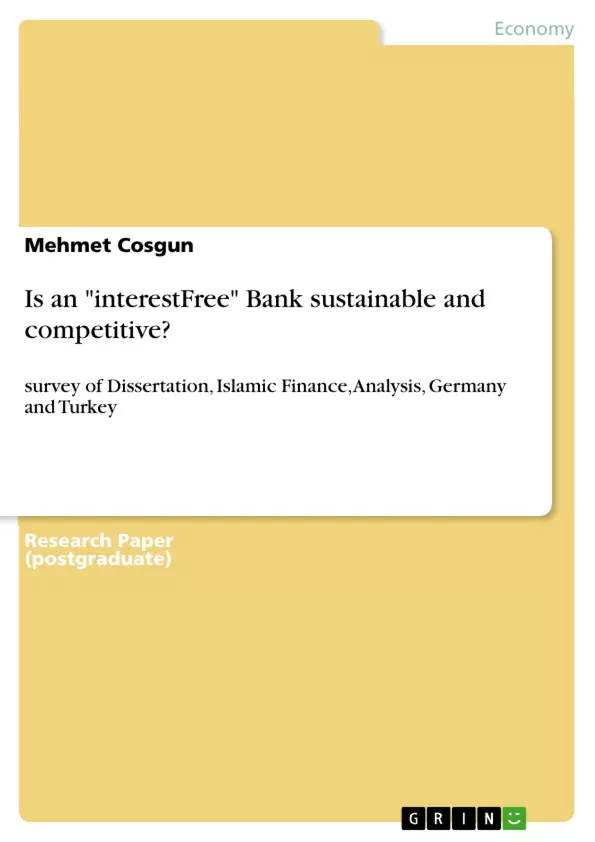This work analyzes whether in recent years Islamic financial developments apply globally, for example to Germany. The author is interested in the reality of Islamic finance and its potential existence in non-Muslim environments? In much of the extant literature, studies consider a theoretical model such as: “The stability of Islamic finance”.
The authors in these studies tend to focus on global Islamic banks. In the present study, the Author wants to examine the situation for a specific non-Muslim country like Germany. The second focus is to find out whether there is a relationship between the number of Muslims in Germany and the need for Islamic financial products. A detailed view of market entry and critical key indicators are analysed. The current laws and their handling by Islamic banks will additionally be examined.
Inhaltsverzeichnis (Table of Contents)
- 1 Introduction
- 2 Objectives and Methodology
- 2.1 Objectives, Research Questions
- 3 Survey of Literature
- 3.1 Islamic Finance
- 3.2 Detail Interest Free
- 3.3 Detail Helal
- 3.4 Internal View of Banks
- 3.5 External View of Customers
- 4 Results
- 5 Discussion
- 6 References
Zielsetzung und Themenschwerpunkte (Objectives and Key Themes)
This work aims to determine if the recent growth of Islamic finance is applicable to non-Muslim countries, specifically focusing on Germany. The author is interested in exploring the reality of Islamic finance and its potential for growth outside of predominantly Muslim regions. The research also seeks to understand if the number of Muslims in Germany correlates with the demand for Islamic financial products. Key themes explored in the work include: * **The Applicability of Islamic Finance in Non-Muslim Countries:** The study investigates the potential for Islamic finance to thrive in environments like Germany, where the majority population is not Muslim. * **Market Entry and Key Indicators:** The author analyzes the factors influencing the entry of Islamic financial institutions into the German market, including relevant laws and regulations. * **The Role of Muslim Population:** The research explores the relationship between the size of the Muslim population in Germany and the demand for Islamic financial products. * **Comparison with Turkey:** The study compares Germany's Islamic finance landscape to that of Turkey, a country with a more established Islamic finance market, to gain insights into market dynamics and growth potential. * **Internal and External Perspectives:** The work investigates both the internal perspective of banks offering Islamic financial products and the external perspective of potential Muslim customers in Germany and Turkey.Zusammenfassung der Kapitel (Chapter Summaries)
- Chapter 1: Introduction: The introduction outlines the purpose and scope of the research, which examines the applicability of Islamic finance in non-Muslim countries, specifically Germany. It contrasts the theoretical studies focusing on global Islamic banks with the author's focus on a specific non-Muslim context. The chapter also highlights the importance of considering the relationship between the Muslim population and the demand for Islamic financial products, as well as the need for a practical, bottom-up analysis of market dynamics.
- Chapter 2: Objectives and Methodology: This chapter delves into the research objectives, highlighting the need for a clear description of Islamic finance's advantages for Muslims in Germany. It addresses the perceived stability of Islamic finance as an alternative to conventional banking, exploring whether this holds true in the specific markets of Germany and Turkey. The chapter also emphasizes the lack of a unified voice in the Muslim world defining the benefits and drawbacks of Islamic finance, particularly in relation to these two countries. The chapter then outlines the methodology, including the distribution of a questionnaire to both residential and business customers and workshops with banks, as well as the framework for analyzing theoretical foundations and practices of Islamic finance in comparison to conventional finance.
- Chapter 3: Survey of Literature: This chapter provides a comprehensive review of literature related to Islamic finance, including its key features, financial instruments, and institutions. It compares Islamic financial practices to those of conventional banking, focusing on the German market and drawing parallels with the Turkish market. The chapter explores the historical and contemporary development of key indicators of Islamic finance, examining the impact of the Muslim population (external view) and the internal perspective of banks in Germany and Turkey.
Schlüsselwörter (Keywords)
The main keywords and focus topics of this work are: Islamic finance, interest-free banking, halal finance, market entry, key indicators, Muslim population, Germany, Turkey, internal view of banks, external view of customers. These keywords represent the primary concepts explored in the research, including the applicability of Islamic finance in non-Muslim contexts, the factors driving market penetration, and the significance of internal and external perspectives.- Quote paper
- Mehmet Cosgun (Author), 2014, Is an "interestFree" Bank sustainable and competitive?, Munich, GRIN Verlag, https://www.grin.com/document/279132



